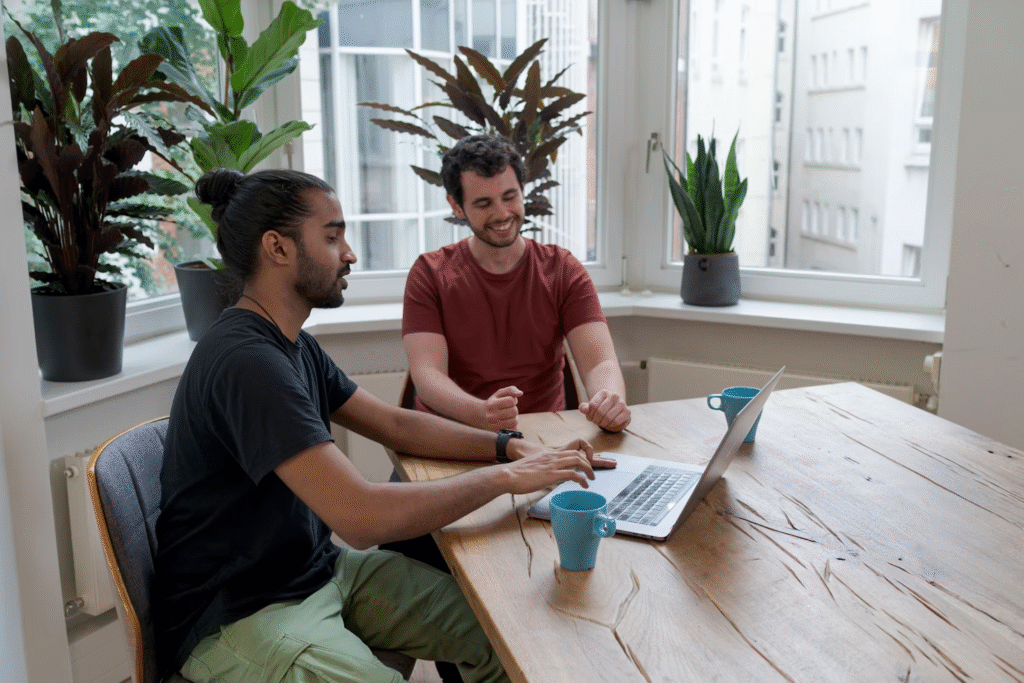
Remember when everyone thought remote work was just a pandemic thing? Yeah, that aged poorly. Here we are in 2025, and the companies crushing it are the ones who figured out that “remote-first” isn’t about where people work—it’s about how you think about work itself.
The difference between remote-friendly and remote-first is like the difference between letting your friend crash on your couch and actually giving them a key to your place. One’s a nice gesture, the other’s a commitment. Remote-friendly companies tolerate distributed work while still centering everything around a physical headquarters.
Remote-first flips the script entirely. Every process, every tool, every meeting starts with the assumption that people aren’t in the same room. This isn’t about forcing everyone to work from home—it’s about making location irrelevant to success.
The landscape in 2025 looks nothing like those chaotic early days of forced remote work. We’ve got better tools, clearer boundaries, and most importantly, we’ve stopped trying to recreate office culture through a screen. The companies winning right now aren’t the ones with the fanciest virtual reality meeting rooms or the most elaborate digital water coolers.
They’re the ones who realized that a distributed team isn’t a limitation to work around—it’s a superpower to leverage. When you can hire the best React developer in Prague, the sharpest product manager in São Paulo, and that brilliant AI engineer in Singapore, why would you limit yourself to whoever happens to live within commuting distance of your office?
Part 1: Laying the Foundation
Starting a remote-first company in 2025 means making some crucial decisions before you write a single line of code. The structure you choose now will determine whether you’re building a company that scales smoothly or one that hits a wall at twenty employees.
First up: your legal structure and where to incorporate. Delaware C-Corps are still popular for venture-backed startups, but if you’re bootstrapping or focusing on profitability over growth, consider alternatives. Some founders are setting up in places like Wyoming or even going international from day one with structures in Singapore or Estonia.
The beauty of remote-first is you’re not tied to Silicon Valley’s playbook anymore. You can incorporate where it makes sense for your business, not where your office happens to be.
Here’s where things get interesting with your technical team. You don’t need to hire ten engineers on day one anymore. Smart founders are mixing full-time hires with engineering outsourcing to specialized firms for specific projects. Maybe you need a full-time CTO and lead developer, but that mobile app? Consider outsourcing it to a team that’s built fifty apps already.
The key is knowing what’s core to your business and what isn’t. Your proprietary algorithm? Keep that in-house. Your admin dashboard that needs basic CRUD operations? That’s perfect for outsourcing.
Setting up your tech stack for a distributed team is where most founders either set themselves up for success or create future headaches. The tools you pick now will shape how your team collaborates for years to come. Start with the basics: Slack or Discord for chat, GitHub or GitLab for code, and something like Linear or Notion for project management.
Don’t go crazy with tools though. I’ve seen startups with fifteen different apps for communication, and nobody knows where anything lives. Pick one tool for each core function and stick with it until it genuinely doesn’t work anymore.
The real secret? Make everything accessible through a browser. If someone needs to install special software just to contribute, you’re already creating friction. Cloud-based development environments like GitHub Codespaces or Gitpod mean a new developer can push code on their first day without spending a week setting up their local environment.
Part 2: Talent Acquisition and Team Building

Finding talent when you’re remote-first is like fishing in the ocean instead of a pond. Sure, the ocean’s bigger, but you need better techniques to catch what you’re looking for. The old spray-and-pray job posting method doesn’t work when you’re competing with every other remote company on the planet.
Instead of posting on job boards and hoping, go where your ideal candidates already hang out. Need a Rails developer? Check out the Rails community forums and Discord servers. Looking for a growth marketer? Find them in the Reforge Slack or commenting on growth-focused newsletters.
This is where independent consultants become your secret weapon. They’re everywhere in 2025, and they’re not just freelancers picking up side gigs anymore. These are often former tech employees who’ve gone solo, bringing enterprise-level expertise without the enterprise-level commitment. Bring them in for three to six months to build something specific or establish a new function.
The beauty of working with independent consultants? They’ve usually seen your problem ten times before. That authentication system you’re struggling with? They implemented it at their last three clients. Plus, the good ones come with their own networks, so when you’re ready to hire full-time, they can recommend people who actually fit.
Creating a remote hiring process that actually works means killing the traditional interview marathon. Nobody wants to do eight rounds of interviews anymore, especially when they’re juggling multiple offers. Front-load the process with actual work instead of hypothetical questions.
Send them a real problem you’re facing and pay them for a day’s work to solve it. You’ll learn more from seeing their actual work than from asking them to reverse a binary tree on a whiteboard. Plus, they get a taste of what working with you is really like.
The other game-changer? Record your interviews (with permission, obviously). Your teammate in Tokyo can watch the conversation with that promising candidate from Berlin without everyone having to find a time that works across three continents. It also helps you reduce bias—when multiple people can review the same interview, you catch things one person might miss.
Part 3: Culture and Communication
Building culture without an office feels like trying to bake bread without yeast—you know something crucial is missing, but you’re not quite sure how to replace it. The water cooler conversations, the random lunch encounters, the energy of a busy office—none of that happens naturally when everyone’s distributed.
So you have to be intentional about it in ways that office-based companies never need to think about. Culture in a remote company isn’t built through pizza Fridays or ping pong tables. It’s built through how you communicate, how you make decisions, and how you treat people when nobody’s watching.
Start with your communication defaults. In an office, the default is synchronous—tap someone on the shoulder and get an answer. Remote-first companies flip this to asynchronous-first. Not everything needs a meeting, and not every message needs an immediate response.
This isn’t just about being respectful of time zones, though that matters when your designer’s in Bangkok and your backend engineers in Budapest. It’s about giving people uninterrupted blocks of time to actually think and create. You know that feeling when you’re finally in the zone and someone schedules a “quick sync”? Yeah, multiply that by ten when every interaction requires a video call.

The balance between async and sync communication is delicate. Too much async and people feel disconnected, like they’re working in a vacuum. Too much sync and you’ve recreated all the worst parts of office culture through a screen. The sweet spot? Default to async for information sharing and updates, save sync for brainstorming, decision-making, and relationship building.
Here’s something nobody talks about enough: documentation becomes your company’s memory when you’re remote. In an office, institutional knowledge spreads through osmosis. Someone overhears a conversation, picks up context from proximity, learns by watching.
None of that exists remotely. If it’s not written down, it didn’t happen.
This means every decision needs a paper trail. Not in a bureaucratic, cover-your-ass way, but in a “three months from now, someone new needs to understand why we chose Postgres over MongoDB” way. Your documentation is how you scale knowledge across time zones and time itself.
The best remote companies treat their internal wikis like products. They have owners, they get updated regularly, and people actually use them. When someone asks a question that’s already documented, you link them to the doc instead of answering again. It feels harsh at first, but it’s the only way to keep documentation alive and useful.
Part 4: Operations and Productivity
Managing projects across time zones is an art form that nobody teaches in business school. You’ve got your morning person in Berlin starting work when your night owl in San Francisco is just going to bed. The traditional 9-to-5 workday becomes meaningless when there’s literally no time when everyone’s online simultaneously.
The solution isn’t forcing everyone into one time zone’s schedule. That’s just colonialism with extra steps. Instead, you design your workflows around handoffs.
Think of it like a relay race where each runner has their own track. Your developer in Sydney fixes bugs while you sleep, hands them off to your QA person in London who tests during their day, who then passes results to your product manager in New York. When done right, work happens around the clock without anyone burning out.
Tools for remote collaboration have exploded since 2020, but more tools doesn’t mean better collaboration. The winners in 2025 are keeping it simple. Figma for design, Linear for engineering tasks, Notion for everything else. The magic isn’t in the tools—it’s in how you use them.
Every tool should have a clear owner and clear conventions. Where do feature requests live? How do you flag something as urgent? When do you use comments versus creating a new task? Without these agreements, your project management tool becomes a digital junk drawer where good ideas go to die.
Measuring productivity without micromanaging is the tightrope every remote manager walks. You can’t see if someone’s at their desk, so the temptation is to track everything. Mouse movements, keyboard strokes, screenshot monitoring—I’ve seen companies try it all.
Here’s the thing: if you’re tracking mouse movements, you’ve already lost. You’ve hired adults, treat them like adults. Focus on outputs, not inputs.
Part 5: Growth and Scaling

Knowing when to bring functions in-house versus keeping them outsourced is like knowing when to buy versus rent. Early on, outsource everything that isn’t core to your product. Customer support, content creation, even parts of your engineering—if specialized firms can do it better, let them.
But as you grow, the calculation changes. That engineering outsourcing firm that was perfect for your MVP might not be the right fit when you need to iterate daily based on user feedback.
Building visibility for your company in 2025 means thinking beyond traditional marketing channels. Everyone’s fighting for attention in the same places. LinkedIn’s oversaturated, Twitter’s a battlefield, and seeing Google as a pagebot and just a pagebot that crawls your site is leaving money on the table.
The smart play? Build where others aren’t. Maybe that’s creating incredible documentation that developers actually want to read. Maybe it’s running workshops that solve real problems. Or maybe it’s building tools that are so useful, people share them without you asking.
Creating processes that scale requires thinking in systems, not solutions. The way you onboard employee number five won’t work for employee number fifty. Build processes that can handle 10x your current size without 10x the complexity.
This means templates for everything, automated workflows where possible, and clear decision-making frameworks. Not bureaucracy—just enough structure to keep things from falling apart when you’re growing fast.
The companies thriving in 2025 aren’t the ones trying to recreate Google’s culture from 2005 or Facebook’s from 2012. They’re writing their own playbooks, building cultures that make sense for distributed teams, and proving that the future of work isn’t about where you work—it’s about how you work together, even when you’re apart.

